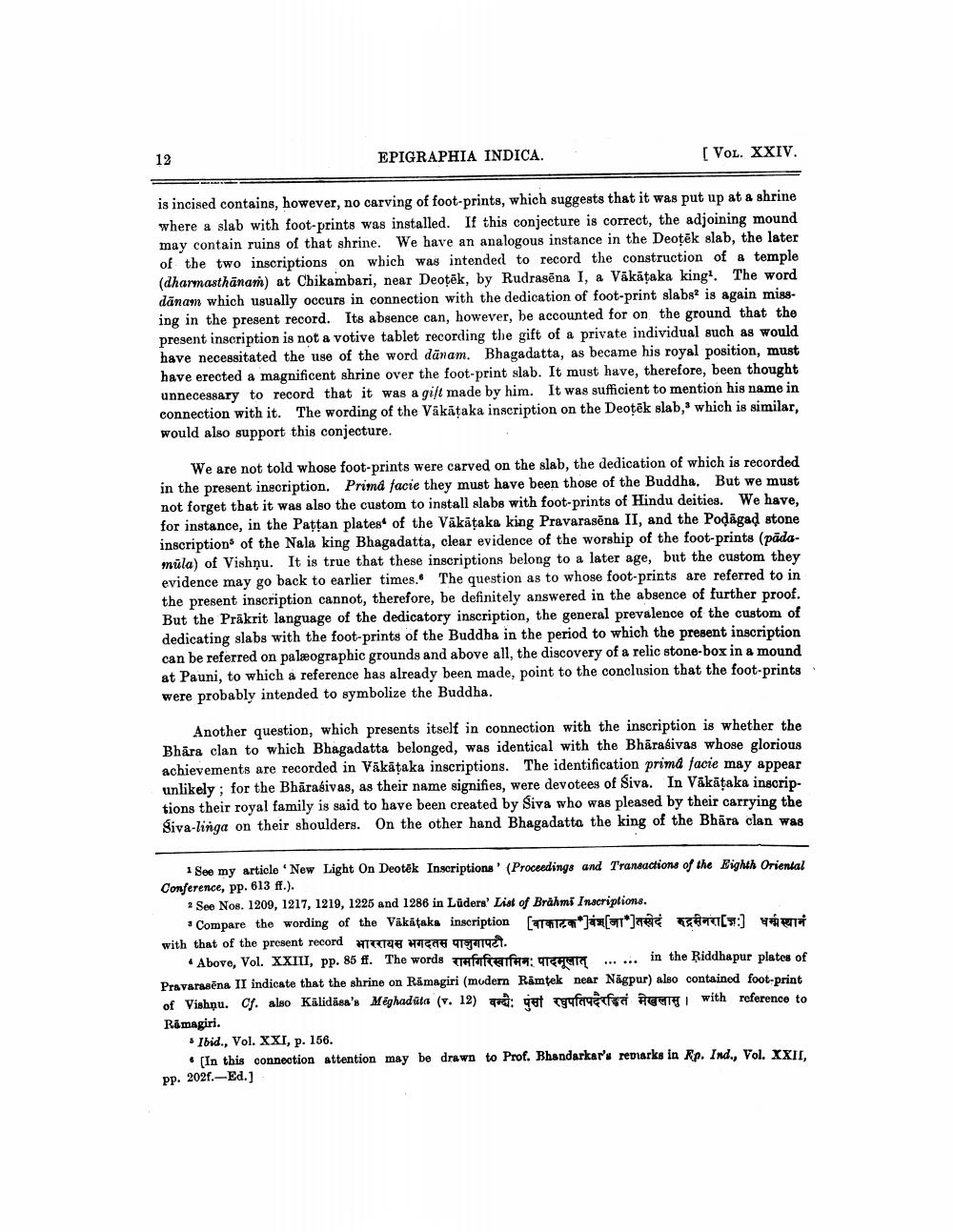________________
12
EPIGRAPHIA INDICA.
[VOL. XXIV.
is incised contains, however, no carving of foot-prints, which suggests that it was put up at a shrine where a slab with foot-prints was installed. If this conjecture is correct, the adjoining mound may contain ruins of that shrine. We have an analogous instance in the Deotek slab, the later of the two inscriptions on which was intended to record the construction of a temple (dharmasthanam) at Chikambari, near Deotek, by Rudrasena I, a Vākāṭaka king1. The word dānam which usually occurs in connection with the dedication of foot-print slabs is again missing in the present record. Its absence can, however, be accounted for on the ground that the present inscription is not a votive tablet recording the gift of a private individual such as would have necessitated the use of the word dänam. Bhagadatta, as became his royal position, must have erected a magnificent shrine over the foot-print slab. It must have, therefore, been thought unnecessary to record that it was a gift made by him. It was sufficient to mention his name in connection with it. The wording of the Väkäṭaka inscription on the Deotek slab, which is similar, would also support this conjecture.
We are not told whose foot-prints were carved on the slab, the dedication of which is recorded in the present inscription. Prima facie they must have been those of the Buddha. But we must not forget that it was also the custom to install slabs with foot-prints of Hindu deities. We have, for instance, in the Paṭṭan plates of the Vakaṭaka king Pravarasena II, and the Poḍagad stone inscriptions of the Nala king Bhagadatta, clear evidence of the worship of the foot-prints (padamula) of Vishnu. It is true that these inscriptions belong to a later age, but the custom they evidence may go back to earlier times. The question as to whose foot-prints are referred to in the present inscription cannot, therefore, be definitely answered in the absence of further proof. But the Prakrit language of the dedicatory inscription, the general prevalence of the custom of dedicating slabs with the foot-prints of the Buddha in the period to which the present inscription can be referred on palæographic grounds and above all, the discovery of a relic stone-box in a mound at Pauni, to which a reference has already been made, point to the conclusion that the foot-prints were probably intended to symbolize the Buddha.
Another question, which presents itself in connection with the inscription is whether the Bhara clan to which Bhagadatta belonged, was identical with the Bharasivas whose glorious achievements are recorded in Vākāṭaka inscriptions. The identification prima facie may appear unlikely; for the Bhārasivas, as their name signifies, were devotees of Siva. In Vākāṭaka inscriptions their royal family is said to have been created by Siva who was pleased by their carrying the Siva-linga on their shoulders. On the other hand Bhagadatta the king of the Bhara clan was
1 See my article 'New Light On Deotek Inscriptions' (Proceedings and Transactions of the Eighth Oriental Conference, pp. 613 ff.).
2 See Nos. 1209, 1217, 1219, 1225 and 1286 in Lüders' List of Brähmi Inscriptions.
Compare the wording of the Vākātaka inscription [ वाकाटक *] वंश [जा* ] तस्येदं रुद्रसेनरा[ज] धर्मस्थानं with that of the present record भाररायस भगदतस पाजुगापटी.
Above, Vol. XXIII, pp. 85 ff. The words wafuftenfan: megeng ... in the Riddhapur plates of Pravarasena II indicate that the shrine on Ramagiri (modern Ramtek near Nagpur) also contained foot-print of Vishnu. Cf. also Kalidasa's Meghadüta (v. 12) av: get gufauxfed with reference to [1 Ramagiri.
...
Ibid., Vol. XXI, p. 156.
[In this connection attention may be drawn to Prof. Bhandarkar's remarks in Rp. Ind., Vol. XXII, pp. 202f.-Ed.]




